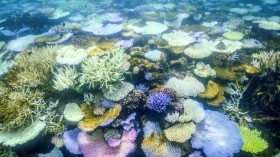Experts have been using NASA's Hubble Space Telescope to take closer looks at potentially Earth-like exoplanets. But in searching for traces of water vapor, they've come up dry.
So far researchers have found that three promising planets, HD 189733b, HD 209458b and WASP-12b, have only one-tenth to one-thousandth the amount of water predicted by current planet formation theories.
Still, researcher Nikku Madhusudhan of the Institute of Astronomy at the University of Cambridge, England, won't let these abysmal readings rain on his parade. The accuracy of the readings is an accomplishment in itself.
"Our water measurement in one of the planets, HD 209458b, is the highest-precision measurement of any chemical compound in a planet outside our solar system, and we can now say with much greater certainty than ever before that we've found water in an exoplanet," he said in a statement. "However, the low water abundance we have found so far is quite astonishing."
According to Madhusudhan, who led the investigation, the fact that these surprisingly dry readings are coming from not just one but three planets thought to be covered with water shows that some textbooks will need rewriting.
"It basically opens a whole can of worms in planet formation," he said. "We have to revisit planet formation and migration models of giant planets, especially 'hot Jupiters,' and investigate how they're formed."
All three exoplanets are so-called "hot Jupiters" because they are relatively close to their stars and boast temperatures between 1,500 and 4,000 degrees Fahrenheit. Yet despite their heat, early data also indicated these planets to be very likely home to high amounts of (potentially boiling) water and water vapor.
This isn't the first time potentially habitable planets haven't lived up to our expectations. Nature World News recently reported how two promising exoplanets turned out to actually be blips on the radar - star activity interference that had appeared like transiting exoplanets during spectroscopic observation.
Yet despite these setbacks, NASA recently reaffirmed its belief that we will find a habitable planet with complex life - if not necessarily little green men waving right back at us - within the next two decades.
You can read Madhusudhan's entire study in The Astrophysical Journal Letters, published on July 24.
© 2024 NatureWorldNews.com All rights reserved. Do not reproduce without permission.

![Microplastics Escape Body's Gut to 'Infiltrate' the Brain, Kidneys and Liver [Study]](https://1471793142.rsc.cdn77.org/data/thumbs/full/70195/280/157/50/40/microplastics-escape-bodys-gut-to-infiltrate-the-brain-kidneys-and-liver-study.jpg)



